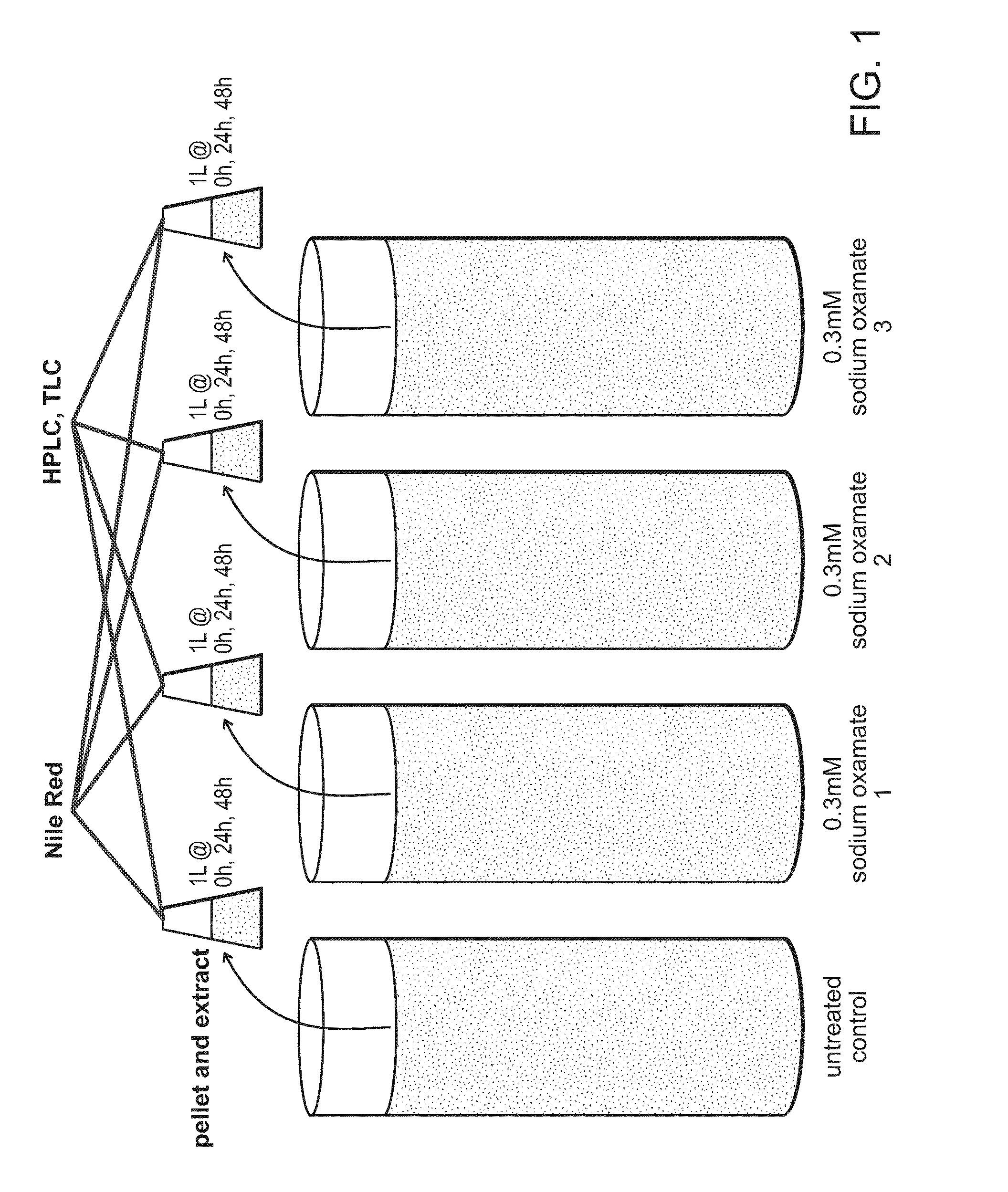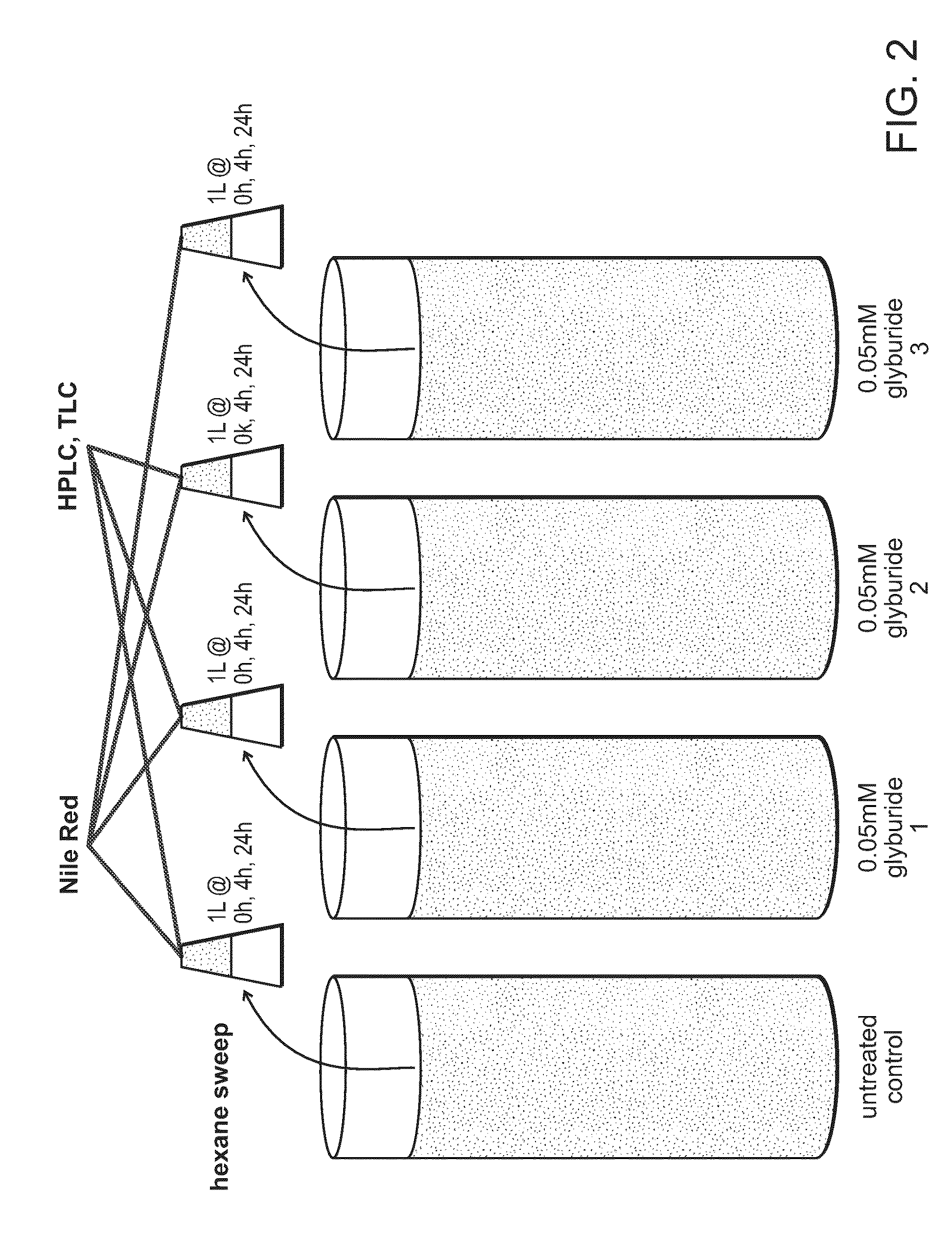Methods and products for generating oils
a technology of oil and oil products, applied in the direction of biofuels, gaseous fuels, fuels, etc., can solve the problems of algae-based biofuels growing in unfavorable traditional agriculture, advanced refining reduces the possibility of gelling at lower temperatures, etc., to promote oil secretion and enhance oil secretion
- Summary
- Abstract
- Description
- Claims
- Application Information
AI Technical Summary
Benefits of technology
Problems solved by technology
Method used
Image
Examples
example 1
Methods
[0158]Sodium Oxamate Dosing: Sodium oxamate was added to three of the four cultures (see FIG. 1). A 1 L sample was collected at time 0, 24 and 48 hours for each culture (a total of 4 samples per time point). The algal cells were pelleted and oils extracted at each time point. Quantitative oil profiles of extracted lipids were generated by TLC and HPLC. The studies demonstrated that 0.3 mM dose of sodium oxamate at scale, including quantitative and compositional analysis of accumulated oil. The experimental approach for sodium oxamate treatment is shown in FIG. 1.
[0159]Glyburide Dosing: After 48 hours, the sodium oxamate time course was complete. The same cultures were used to conduct a scaled trial of the glyburide compound (experimental approach is shown in FIG. 2). A 1 L sample of each culture was collected and treated to recover oil outside the cells (if any) at t=0. The three cultures that had previously been treated with sodium oxamate were subsequently treated with 0.05...
example 2
Methods
Growth and Maintenance of Schizochytrium
[0179]The media used for maintaining Schizochytrium is 790 BY+ medium. It is prepared as follows. 1.0 g of yeast extract, 1.0 g of Peptone and 5.0 g of D+ Glucose were added to an autoclaveable glass bottle with 1 L of sterile sea water. The mixture was autoclaved at 121 C.° for 15 minutes.
[0180]Schizochytrium were removed from liquid nitrogen storage tank. 100 mL of 790 BY+ medium was added to a 250 mL Erlenmeyer flask. The cells were thawed in at 37 C.° water bath until completely liquid and then transferred to the 250 mL Erlenmeyer flask. A foam stopper was placed in the flask opening and the flask was placed on a shaker stirrer. Once every 7 days 2 mL of the Schizochytrium were transferred into a new 250 mL Erlenmeyer flask containing 100 mL of 790 BY+ medium.
[0181]For flow cytometric analysis, the desired number of flow tubes were labeled (4 per treatment group). For microscopy, the desired number of microscope slides were labeled...
example 3
Enhanced production of oils in P. Parvum
[0188]A control culture of P. Parvum was grown and split into two 500 mL cultures. Glyburide was added to one of the cultures and the culture was shaken for 24 h.
[0189]After the cultures sat for an hour an oily sheen that was much more prevalent on the surface of the glyburide treated culture than the control culture was observed. Interestingly, the sheen appeared with glyburide treatment, even in the absence of oxamate.
[0190]A 1 L P. parvum culture (˜2 million cells / mL) treated with oxamate was split into two subcultures of 400 mL each. Glyburide dissolved in DMSO was added to one subculture. The other subculture received the DMSO carrier (control) that the glyburide had been dissolved in. The two cultures were incubated on the shaker for 24 h and subsequently off the shaker for ˜2 h.
[0191]The glyburide treated culture appeared to have a number of swirls on the surface, apparently made by the oil secreted from the cells. The control culture,...
PUM
| Property | Measurement | Unit |
|---|---|---|
| pH | aaaaa | aaaaa |
| pH | aaaaa | aaaaa |
| time | aaaaa | aaaaa |
Abstract
Description
Claims
Application Information
 Login to View More
Login to View More - R&D Engineer
- R&D Manager
- IP Professional
- Industry Leading Data Capabilities
- Powerful AI technology
- Patent DNA Extraction
Browse by: Latest US Patents, China's latest patents, Technical Efficacy Thesaurus, Application Domain, Technology Topic, Popular Technical Reports.
© 2024 PatSnap. All rights reserved.Legal|Privacy policy|Modern Slavery Act Transparency Statement|Sitemap|About US| Contact US: help@patsnap.com










